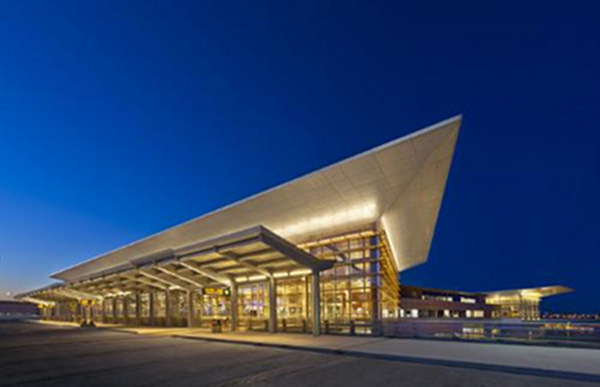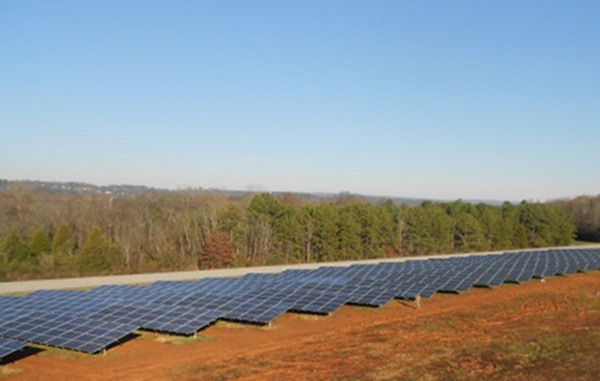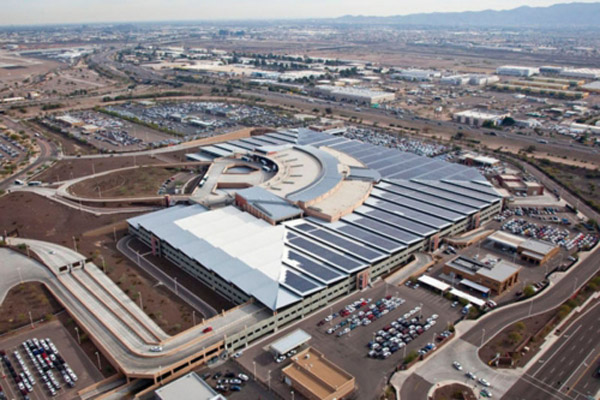It’s no secret that air travel itself comes with a fairly hefty ecological tab. (In fact, according to the carbon offset service TerraPass, one round-trip direct flight from San Francisco to New York City racks up over 2,000 pounds of greenhouse gases.) But increasingly, airports themselves are taking measures to decrease the carbon footprint of their day-to-day operations, if not the amount of fuel expended in the course of a cross-country flight.
This efforts, largely, have taken two forms: LEED certification and solar power (and, in some cases, both).

One the of the highest-profile cases of green building certification is San Francisco International Airport’s new Terminal 2, which gained LEED Gold certification last spring, just in time for its first commercial flight. Built to house Virgin America’s Bay Area operations, SFO’s $383 million renovation of Terminal 2 was the first LEED-registered airport project, and one of the first airport terminals in the world to gain green building certification through the U.S. Green Building Council. Its green features include natural daylighting, improved ventilation, composting and recycling receptacles, low-flow water fixtures, and energy-efficient lighting and machinery. The building was constructed with sustainable building materials, including terrazzo flooring with recycled glass chips, recycled-content carpet and structural steel.
This is Virgin America we’re talking about, though, so the gee-whiz doesn’t end there: Terminal 2 also features a food court featuring local, organic vendors and producers — including restaurants by noted Bay Area chefs — more computer connections, a free “hydration station” for refilling bottles with tap water (post-security), and a kids’ play area.
SFO’s Terminal 2 LEED Gold certification came hot on the heels of Mineta San Jose International Airport (SJC)’s LEED Silver certification for its brand-new Terminal B, making the regional trend in California pretty clear.

In the South, we’ve seen both the Hartsfield-Jackson Atlanta International Airport (ATL) in Georgia and the Chattanooga Metropolitan Airport (CHA) in Tennessee take LEED certification, the former at the Silver level for its new Maynard H. Jackson International Terminal, the latter at the Platinum for its corporate flight center terminal facility. ATL’s green terminal gained certification for its focus on energy efficiency, water conservation and healthy indoor air quality, among other green features. Its low-flow water fixtures alone are expected to save ATL up to 40,000 gallons of water a year.
CHA’s new corporate flight center, like Indianapolis International Airport (IND)’s Midfield Terminal complex, makes use of a whole lot of solar. So far, 1 megawatt (MW) of a planned 3 MW solar power project is up and running in powering airport operations at CHA, and the solar farm at IND — when complete at the end of the year, expected to be one of the country’s largest such facilities — is rated at more than 15 million kilowatt hours of power per year.

Beating out both of those installations, however, are the solar farms at Phoenix Sky Harbor Airport (PHX) and the Denver International Airport (DIA). The former comprises 5.4 MW over the rooftops of its rental car center and the two buildings that comprise the airport’s east economy garages, and currently generates the equivalent of 51 percent of the electricity used by those facilities. The later — with the recent completion of a 4.4-MW addition — brings the airport’s total amount of hosted solar power to more than 8 MW, the most solar generation of any commercial airport in the United States.

Such airport additions don’t come without complications. Recently, a quarter of the panels in New Hampshire’s biggest solar power array — the one atop a parking garage at Manchester-Boston Regional Airport — had to be covered with tarps after air traffic controllers said glare from the panels was distracting them. Apparently, the glare is only an issue for less than an hour on sunny mornings, but that’s enough to be a concern, showing just how tricky the issue of siting solar power at airports can be.
Still, with both renewable energy and green building increasingly more common all over the U.S., it’s increasingly likely that someday soon, you may find yourself taking off from one green airport and touching down, hours later, in another.